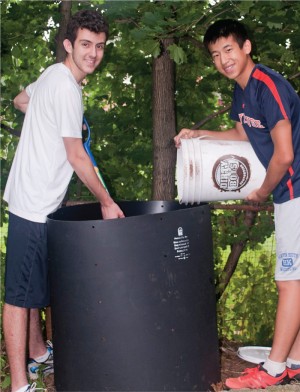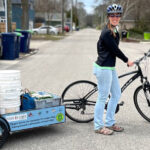BioCycle July 2015
Newton, Massachusetts: Dirty Boys Composting
Grant Berman started Dirty Boys Composting with a friend in 2014 during their sophomore year in high school. The boys were driven by their interest in having the same job and hours, improving the environment and being outdoors. After over a year of installing and maintaining more than 70 backyard composting piles throughout the city of Newton, Dirty Boys Composting sites are diverting around 80 tons of food scraps and leaves per year from the city’s waste stream. Two types of services are offered. For households already composting but needing some assistance, Dirty Boys charges $70 to do a compost pile evaluation and remediation, including a Newton-bred red wiggler worm infusion; one composting education and overview session; two additional compost pile check ups; and availability for on call composting consultation. It also has started offering a compost pile screening service.
Its starter package ($125) includes an initial consultation; delivery and installation of a 24 cu. ft. New Age Composter; and a jump-start on the composting pile (adding active compost from an existing bin), which includes the Newton-bred red wiggler worm infusion. The starter package comes with the education session, compost pile check ups and on-call consultation as well.
When the 2015 season got underway, Berman and his coworker started sifting and screening compost bins and removing the useable compost. “So far, everyone has been pleased with the quantity and quality of their compost,” notes Berman. “After removing the useable compost, we’ve been restocking customers’ bins with the remaining partially decomposed matter and adding additional nutrients.” A new addition in 2015 is a WORX leaf mulcher and shredder. “After doing a lot of research over the winter about the best ways to speed up the composting process, I found out that shredding leaves makes a huge difference,” he adds. “So, all customer bins will now be amended with shredded leaves.”
Minneapolis, Minnesota: Twins Step Further Away From Landfill
To boost its admirable 2014 waste diversion rate of 73 percent, the Minnesota Twins baseball club started the 2015 season by switching to 100 percent compostable serviceware and eliminating “Trash” bins at its Target Field, now using only “Recyclable” and “Compost” bins. The change was designed to make it easier for fans who can now put all plates, utensils and trays into the compostable bin — along with any leftover food. “It’s hard to get fans to first scrape the cheese off a plastic plate and then toss the cheese in one bin and the plate into another,” explains Wendell Simonson of Eco-Products, the Twins’ supplier of the compostable serviceware. “Only a systematic approach to packaging, or one that enables everything outside of recyclables like bottles and cans to be compostable, makes waste diversion rates of 90 percent or above possible. Keeping things simple is crucial to making this work.” As a result of the change, the only remaining noncompostable or nonrecyclable waste items are films in items like popcorn and peanut bags, and certain souvenirs like the plastic baseball helmets used for big nachos. “It is only the outlier bits, anything we don’t have a great compostable option for,” adds Simonson.
Previously, with the exception of bottle and can recycling, all source separation for waste diversion was done in the back of the house; compostable materials were picked out of the trash bin waste. “Knowing they wanted to get to a higher diversion rate, we said, `Why don’t we do this in a way that is more visible to fans?’,” he says. Any noncompostable foodservice items were replaced, and the trash bins were converted to bins for compostables. “Now, in the back of the house, instead of sorting out compostables from the trash, they are sorting out remaining trash from compostables,” notes Simonson. Separated organics are sent to SKB in Minneapolis, for composting.
To educate fans about the change, the Minnesota Twins organization is using in-stadium communication, including specially branded Eco-Products compostable serviceware with artwork showing how the products are different and belong in the compostables bin. “There’s no better time to reach fans than when they’re taking in a baseball game and enjoying a cold beer,” he continues. “They’re holding a cup and seeing that it doesn’t have to go to a landfill. That’s a powerful feeling to be part of something good.” And according to EcoPulse, an annual national survey conducted by Knoxville, Tennessee-based The Shelton Group, the initiative could also be good for concession sales. Its study of 2,015 respondents found one in five Americans would buy more beer, soft drinks and nachos at a stadium if they learned that all of the trash left behind was recycled or composted.
Cambridge, Massachusetts: Curbside Organics Pilot Data
In 2012, the Massachusetts Department of Environmental Protection (MassDEP) awarded the City of Cambridge a $73,304, 2.5-year grant to research, plan and possibly implement a pilot curbside food scraps collection program for residents. Phase One, a feasibility study, was completed in 2012; Phase Two, a one-year pilot program for curbside organics collection, was completed in March 2015. The city selected households serviced on its Monday collection route. The final results: 647 participating households in 424 residences diverted 85 tons or 170,000 lbs of organics from incineration and landfill, avoiding 76 tons of CO2 emissions. Organics were delivered to Rocky Hill Farm in Saugus, Massachusetts for composting.
For the pilot, participating households received a MaxAir green kitchen container to collect food scraps and soiled paper, a year’s supply of BioBags to line the kitchen container (both donated by BioBag), and a green Orbis curbside bin. Collection was free and offered on households’ normal collection day (same as recycling, yard waste and trash). Participants were asked to answer a few online surveys over the course of the pilot. Based on the success of the pilot, the City of Cambridge decided to expand curbside organics pick up to all 2,525 eligible residences on the Monday route in Fall 2015. The intent is to expand citywide within two years, and to 13+ unit multifamily buildings on a case-by-case basis in subsequent years. The City will initially contract for collection with a private hauler to achieve needed collection efficiencies.
Among the best practices for effective programs learned over the course of the pilot are: Provide supplies for free to make participating easy; Aim to engage with as many buildings as possible, in person in the neighborhoods through door to door outreach; Collect email addresses of participants to communicate regularly; Provide training programs to residents/building managers with incentive to receive supplies or rebates; Conduct recurring outreach to large multifamily buildings, targeting high turnover times of year to reeducate residents; Involve children to bring the message into the home and build cultural norms. Use high school students as volunteers.
Tucson, Arizona: Cactus To Compost
Cheri Romanoski grew up appreciating the desert’s natural resources. A former elementary school teacher, she introduced her students to desert flora and fauna and how indigenous peoples survived on that bounty. Since then, it’s been a three decade fun run for Cheri’s Desert Harvest, which produces nearly three dozen products from “salvaged” prickly pear cactus fruit. “There’s a tremendous amount of cactus fruit that just ripens and falls by the wayside, deteriorating into ant food,” Romanoski explains. “It does no harm when we pick it because it just regenerates new fruit the following year.” In springtime, prickly pear plants generate yellow flowers that last only a few days before their blossoms fall off and the stem forms a bulb-like green fruit. When monsoon rains arrive in July, the fruit grows, turning a dark red color while ripening.
“While the fruit ripens at different times, we typically harvest over 30 tons (traditionally about 70,000 pounds) during a 6- to 8-week picking season from late July to early September,” she says. “We wash and steam them, and press them to extract the juice that is filtered and graded for color and viscosity. Then it goes into a freezer until I’m ready to cook.” Romanoski adds that she has always been a reuse, recycle, don’t-throw-it-away person. “I used to donate pressed cacti to ranchers to tamp down dust in their corrals, but I thought ‘there’s got to be something beyond this’. So we experimented with making things out of the crush residue, like fireplace logs and high fiber biscuits and pellets for zoo animals.” And compost is made with whatever remains, she says. “All parts of the fruit have been used for something functional with the remnants returned to nature to enrich the soil for future generations.”— Lee Allen















